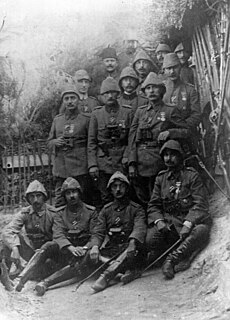
The First Balkan War lasted from October 1912 to May 1913 and involved actions of the Balkan League against the Ottoman Empire. The Balkan states' combined armies overcame the initially numerically inferior and strategically disadvantaged Ottoman armies and achieved rapid success.

The Third Army was originally established in Skopje and later defended the northeastern provinces of the Ottoman Empire. Its initial headquarters was at Salonica, where it formed the core of the military forces that supported the Young Turk Revolution of 1908. Many of its officers who participated in the Revolution, including Enver Pasha and Mustafa Kemal Atatürk, rose to fame and power.
The Second Army of the Ottoman Empire was one of the field armies of the Ottoman Army. It was formed in the late 19th century during Ottoman military reforms.
The First Army or First Guards Army of the Ottoman Empire was one of the field armies of the Ottoman Army. It was formed in the middle 19th century during Ottoman military reforms.
The I Corps of the Ottoman Empire was one of the corps of the Ottoman Army consisting of ethnic Albanians. It was formed in the early 20th century during Ottoman military reforms
The II Corps of the Ottoman Empire was one of the corps of the Ottoman Army. It was formed in the early 20th century during Ottoman military reforms.

The III Corps of the Ottoman Empire was one of the corps of the Ottoman Army. It was formed in the early 20th century during Ottoman military reforms.
The IV Corps of the Ottoman Empire was one of the corps of the Ottoman Army. It was formed in the early 20th century during Ottoman military reforms. It was disbanded at the end of World War I.
The V Corps of the Ottoman Empire was one of the corps of the Ottoman Army. It was formed in the early 20th century during Ottoman military reforms.
The VI Corps of the Ottoman Empire was one of the corps of the Ottoman Army. It was formed in the early 20th century during Ottoman military reforms. It is most notable for its participation in the offensive phase of the 1916 Romanian Campaign of World War I, where it was involved in heavy action all throughout the five months, inflicting heavy casualties on the Russo-Romanians and breaking through the Allied lines in several key areas. Additionally the VI Corps took 8,512 prisoners in Romania, including 6,512 Russians and 2,000 Romanians.
The VII Corps of the Ottoman Empire was one of the corps of the Ottoman Army. It was formed in the early 20th century during Ottoman military reforms.
The X Corps of the Ottoman Empire was one of the corps of the Ottoman Army. It was formed in the early 20th century during Ottoman military reforms.
The Firzovik Detachment of the Ottoman Empire was one of the Detachments under the command of the Ottoman Vardar Army of the Western Army. It was formed in Firzovik area during the First Balkan War.
The Taşlıca Detachment of the Ottoman Empire was one of the Detachment under the command of the Ottoman Vardar Army of the Western Army. It was formed in Taşlıca area for the defense of the Sanjack of Yenipazar during the First Balkan War.
The İpek Detachment of the Ottoman Empire was one of the Detachment under the command of the Ottoman Western Army. It was formed in İpek area during the First Balkan War.
The Yanya Corps or Independent Yanya Corps of the Ottoman Empire was one of the major formations under the command of the Ottoman Western Army. It was formed in Yanya area during the First Balkan War. Its commander was Esat Pasha. It fought the battles of Gribovo and Pente Pigadia against the Greek Army of Epirus. Pushed back to the Yanya Fortified Area, it held out against two Greek assaults but was eventually defeated and capitulated at the Battle of Bizani in 4–6 March 1913.
The Scutari Corps, Işkodra Corps or Shkodër Corps of the Ottoman Empire was one of the corps under the command of the Ottoman Western Army. It was formed in Scutari area during the First Balkan War.
The Kırcaali Detachment of the Ottoman Empire was one of the Detachments under the command of the Ottoman Eastern Army. It was formed in Kırcaali area during the First Balkan War.
The Priştine Detachment of the Ottoman Empire was one of the Detachments under the command of the Ottoman Vardar Army of the Western Army. It was formed in Priştine area for the defense of Kosovo during the First Balkan War.
The Chataldja Army or Çatalca Army of the Ottoman Empire was one of the field armies of the Ottoman Army. It was formed after Ottoman retreat to the Chataldja line during the First Balkan War. It confronted Bulgarian forces. It was organized from units of dissolved First Eastern Army and Second Eastern Army on November 7, 1912.